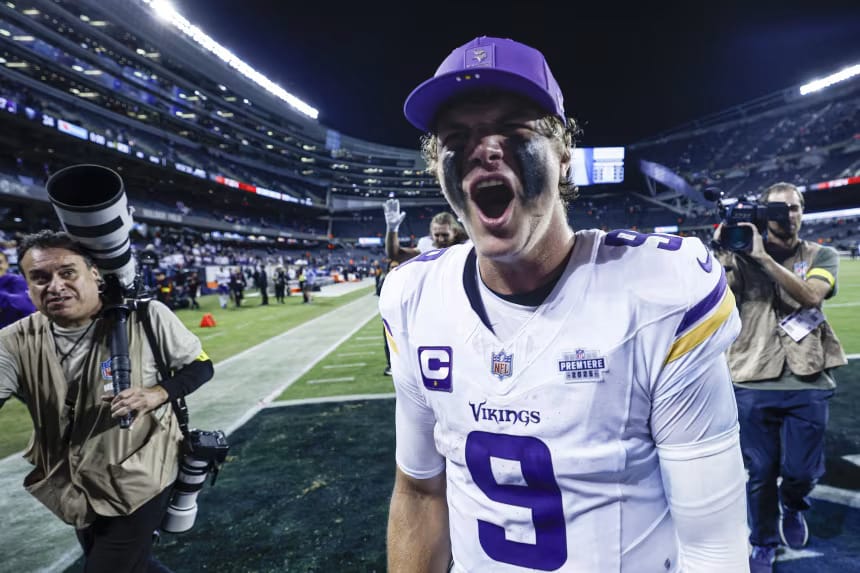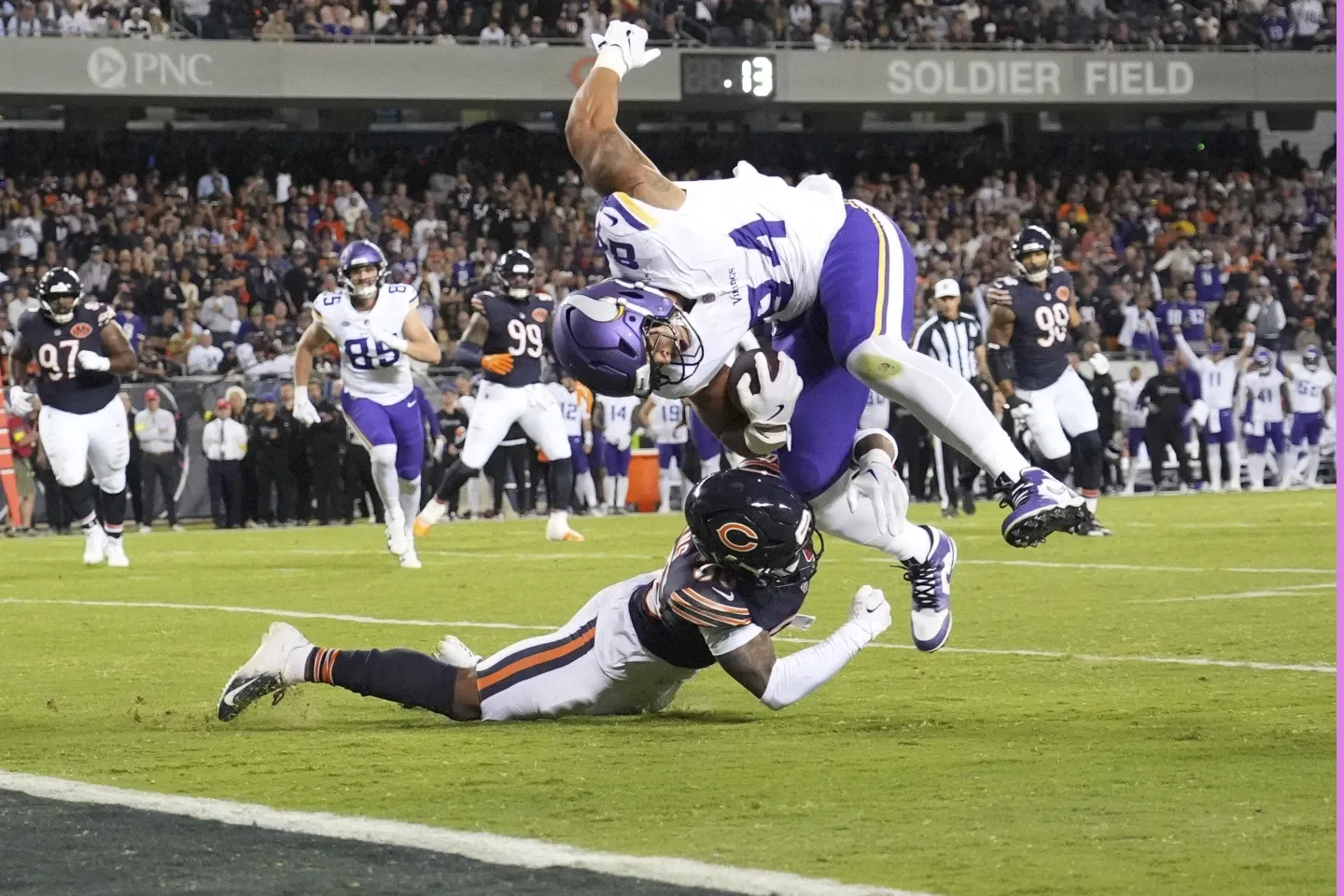J.J. McCarthy's Epic NFL Debut: A Fourth-Quarter Comeback for the Ages
J.J. McCarthy's NFL debut was a tale of two halves. After a shaky start, the rookie quarterback staged a dramatic fourth-quarter comeback against the Chicago Bears on Monday Night Football, solidifying his role as the Vikings' new leader.

Written by Lavanya, Intern, Allegedly The News
CHICAGO, September 10, 2025
The narrative around rookie quarterbacks entering the NFL is often a study in patience. For every Patrick Mahomes, there are countless others who struggle to find their footing. For Minnesota Vikings rookie quarterback J.J. McCarthy, his highly anticipated NFL debut on Monday Night Football against the rival Chicago Bears offered a glimpse into both sides of that coin. What began as a turbulent, mistake-ridden performance in the first three quarters transformed into an electrifying, record-setting comeback in the fourth. McCarthy’s gritty performance in his home state didn't just secure a 27-24 win; it was a watershed moment that may have fundamentally altered the trajectory of the Vikings' season and solidified his place as the future of the franchise.
The stage was set for a classic NFC North rivalry game at Soldier Field. All eyes were on the young quarterbacks, McCarthy for the Vikings and the Bears' Caleb Williams, the No. 1 overall pick in 2024. McCarthy, the No. 10 pick in the 2024 draft, had sat out the 2024 season with a torn meniscus. His first official NFL action, in a primetime slot, was a massive moment. The pressure was palpable, and for the first 45 minutes, it looked like it was too much.
The Early Struggles: A Play-by-Play Breakdown
The first three quarters of McCarthy's debut were a microcosm of the challenges faced by any rookie QB. The Vikings' offense looked out of sync, hampered by inconsistent protection and a seeming inability to find rhythm. A timeline of the early struggles is essential to understanding the gravity of his eventual comeback:
- First Quarter: The Vikings' offense sputtered, managing just two first downs on their first three drives. McCarthy, under constant pressure, was sacked twice. He completed only two of his five passes, resulting in just 18 total yards. The offense was stuck in neutral.
- Second Quarter: The Vikings offense showed a small pulse, managing two field goals by rookie kicker Will Reichard, including a career-long 59-yarder that tied a Soldier Field record. Despite the points, McCarthy continued to struggle. He completed just three of his next four passes for a mere 30 yards. The Vikings’ offense tallied only 80 total yards in the first half and just four first downs. Star wide receiver Justin Jefferson, the cornerstone of the offense, had just one catch for 13 yards. The Minnesota offense was lethargic and uninspired.
- Third Quarter: The nadir of the game arrived early in the second half. Facing a third-and-three from his own 34-yard line, McCarthy forced a throw to Justin Jefferson that was jumped by Bears cornerback Nahshon Wright. The result was a 74-yard interception returned for a touchdown, extending Chicago's lead to 17-6. The rookie mistake was a gut punch, and on the broadcast, Hall of Fame quarterbacks Peyton and Eli Manning immediately broke down the play, with Peyton warning, "He never backed out of his backpedal, you can't throw it if that corner doesn't back up." At that moment, the narrative seemed set: the first Monday Night Football game of the season would be remembered for McCarthy's struggles and the Bears' dominant defense.
The Unstoppable Fourth-Quarter Rally
Instead of crumbling under the pressure, McCarthy used the interception as fuel. The turning point came not from a great offensive play but from a Bears miscue. After the pick-six, the Chicago offense went three-and-out, and on the ensuing field goal attempt, kicker Cairo Santos missed from 50 yards out. That missed kick, however small, gave the Vikings new life. With 12:44 left in the game and trailing 17-6, the Minnesota offense took the field. The comeback was about to begin.
The First Strike: Getting on the Board
The first possession of the fourth quarter was a statement drive. Starting from their own 40-yard line, the Vikings went on a five-play, 60-yard drive. It began with a 19-yard run by running back Jordan Mason, a sign that the Vikings were going to establish the run to open up the passing game. McCarthy then found Justin Jefferson for a 17-yard gain, finally getting his best weapon involved. Two plays later, McCarthy hit Jefferson again, this time for a 13-yard touchdown. The connection, born out of a tough third quarter, was a crucial display of trust. While the two-point conversion failed, the Vikings had cut the lead to 17-12. The fire had been lit.
Taking the Lead: A Perfect Pass
The Vikings' defense, energized by the offensive surge, held the Bears to another three-and-out. With 9:56 remaining, McCarthy and the offense returned to the field. He wasted no time. On the first play of the drive, he connected with tight end Aaron Jones for a 27-yard touchdown, a perfectly thrown lob pass over a defender that gave Minnesota its first lead of the game at 20-17. The poise and quick-strike ability were reminiscent of a veteran, not a rookie in his first-ever game. The play took just three snaps and signaled that McCarthy was no longer playing conservatively; he was attacking.
The Game-Sealing Dagger: A Rookie's Touchdown Run
The Bears managed to tie the game at 20-20 with a field goal on their next possession. However, with 6:18 left, McCarthy was given the ball back, and he delivered the ultimate game-winning drive. Starting from their own 25, the Vikings marched down the field on a methodical nine-play, 68-yard drive. The drive showcased McCarthy's dual-threat ability. He had a 12-yard run on a read-option play to get a first down, and a 16-yard pass to wide receiver Adam Thielen to get the Vikings in the red zone. With less than three minutes to go, McCarthy delivered the knockout blow. On a read-option play, he faked the handoff and sprinted 14 yards untouched into the end zone, a thrilling moment that put the Vikings up 27-20. The touchdown was a defining moment, showcasing not just his arm talent but his athleticism and vision. The Bears would score another touchdown, but it was too little, too late. The Vikings held on for a 27-24 victory.

Making History and Setting the Tone
The statistics themselves, while solid (13 of 20 for 143 yards, 2 TDs, 1 INT, and a rushing TD), don’t tell the full story. It was the timing and nature of McCarthy’s plays that cemented his place in NFL history. He became the first quarterback since Hall of Famer Steve Young in 1985 to overcome a double-digit fourth-quarter deficit in his NFL debut. He also made NFL history by becoming the first player to record three touchdowns (two passing, one rushing) of at least 10 yards in the fourth quarter of his debut.
The coaching and strategic adjustments were also critical to the win. Head coach Kevin O'Connell's faith in his young signal-caller never wavered. Instead of pulling him or reverting to a purely run-heavy offense after the interception, he empowered McCarthy to win the game. This stands in stark contrast to the first three quarters, where the offense seemed to be playing tentatively. The decision to let McCarthy take control in the fourth quarter proved to be the winning strategy, exploiting a tiring Bears defense that was without key players like cornerback Jaylon Johnson and linebacker T.J. Edwards.
The Postgame & The Unwritten Narrative
Post-game, the sentiment was clear. The Vikings believed they had found their guy. "We don't win this game unless J.J. plays the way he did in the second half," said Coach O'Connell. "Most importantly, he kept the belief of this football team behind him, and now, we know it's possible." McCarthy, ever the stoic and humble leader, focused on the team's resilience.
This debut should be seen in the context of his college career. McCarthy was a winner at Michigan, finishing with a 27-1 record as a starter and a national championship. While his college numbers weren't eye-popping, his ability to perform in clutch moments and his leadership were undeniable. He was a quarterback who elevated those around him. In his first NFL game, he proved that this quality was not just a college-level trait.
A Glimpse into the Future
J.J. McCarthy’s NFL debut was a tale of two distinct halves. The first was a stark and unforgiving reminder of the immense pressure and the difficult learning curve for rookie quarterbacks. The second was a dramatic, breathtaking display of his true potential. His ability to rally from a disastrous mistake and lead his team to victory against a fierce rival on a national stage suggests that the Vikings have found their franchise quarterback. This wasn’t just a win; it was a defining moment. It was the kind of performance that a fanbase can latch onto, a reason to believe. The Vikings know what they have in McCarthy, and now, so does the rest of the NFL.
The New Questions
How will the Vikings’ offensive line and coaching staff continue to adjust to provide McCarthy with better protection and more consistent play calls in future games? Will McCarthy be able to sustain this level of poise and leadership throughout the season, or was this a one-game wonder that will be a difficult act to follow?
Sources
NFL.com, The Associated Press, ESPN, and verified team and media reports from the Monday Night Football broadcast.




